This case history presents two examples of single vibrator, single sweep, 3D seismic data acquired in Alberta during 2013. The first example, from Western Alberta in the Duvernay play fairway, used full size vibrators and was acquired as a zero-risk validation of the technique at the end of a conventional 3D vibroseis survey. The second example, from Eastern Alberta, was acquired using only the single vibrator, single sweep, method with mini-vibrators. In both examples all field data were recorded as uncorrelated single sweeps, and no attempt was made to perform any kind of simultaneous or over-lapping sweep effort in the field for the data examples discussed in this article.
The ultimate objective of the tests was to demonstrate that the single vibrator, single sweep, method delivers an increased trace density and an increased trace diversity in the pre-stack domain at a competitive cost compared to conventional surveys. It should also show an improved final data quality compared to that obtained from conventional multi-vibrator fleets or from conventional explosive sources. In short, we wanted to answer the question “Can single vibrator, single sweep, 3D acquisition be better, cheaper and faster in WCSB than current acquisition methods?”
Single Vibrator, Single Sweep Methodology
The single vibrator, single sweep, data acquisition technique is now well established in more traditional vibroseis operating areas such as the Middle Eastern deserts (Meunier, 2005; Bouska, 2010). The use of one sweep per VP is the logical extension of an observation made by Quigley (2000) that “the spatial distribution of (vibroseis) source energy, improving the trace offset distribution and increasing the CMP fold is seen as significantly more important than the sweep effort/VP”. Similarly, Cooper (2002) stated that “Higher vibroseis effort should be accomplished by generating more records at frequent source intervals rather than using more sweeps at sparse source intervals”.
In the Middle East there are usually few surface obstacles for the vibrator trucks. As a result, onshore 3D production levels similar to, or even exceeding, those of open water marine 3D’s are now possible without compromising data quality (Burger, 1999; Pecholcs, 2010). This requires the use of a variety of simultaneous sweeping techniques that have evolved over the last 18 years. These are either based on, or else incorporate, the slip-sweep concept (Rozemond, 1996; Wams, 1998) with two recent variations being “ISS” – Independent Simultaneous Sweeping (Howe, 2008) and “DS3” – Distance Separated Simultaneous Sweeping (Bouska, 2010).
These simultaneous sweeping methods can be evaluated at zero technical risk through simulation in the data processing center using uncorrelated, non-overlapping, single sweep, data acquired from a conventional 3D vibroseis survey (Thacker, 2000).
The individual field records from a single vibrator, single sweep, survey may exhibit a lower signal-to-noise ratio than those recorded from a traditional vibroseis survey acquired using either a multiple vibrator fleet operation, or else a multiple summed sweep per VP operation, or else a combination of the two. However, the advantages of the single-sweep point-source become apparent in the processing center, where the improved spatial sampling allows a wide range of noise rejection and signal enhancement routines to be applied. Both source-generated noise and ambient noise can be eliminated more effectively, and higher frequency reflection signal can be retained through to the final pre-stack or post-stack products.
Duvernay Test Data
Although the surface conditions in the Western Canada prairies are often less favourable for the efficient operation of multi-vehicle vibrator fleets, we propose that with appropriate planning the efficient execution of single vibrator, single sweep, operations can be achieved. In early 2013 Talisman Energy Inc took advantage of a conventional, proprietary, vibroseis 3D survey in the Duvernay area to test this concept in the Western Canada Sedimentary Basin.
The Duvernay 3D was acquired using 9 vibrators (I/O AHV III and IV, 62,000 lbs Hold-Down Weight), distributed between three fleets, with three vibrators per fleet. The source effort was one sweep per VP using a non-linear, EmphaSeis , up-sweep (4-100 Hz, 16 seconds). The VP’s were located at 25m intervals along the source lines, resulting in a total source effort of 1,920 vibrator-sweep-seconds per source line kilometer. The recording spread consisted of 16 lines of 144 channels with a 50m station interval and the shot records were recorded both uncorrelated and correlated.
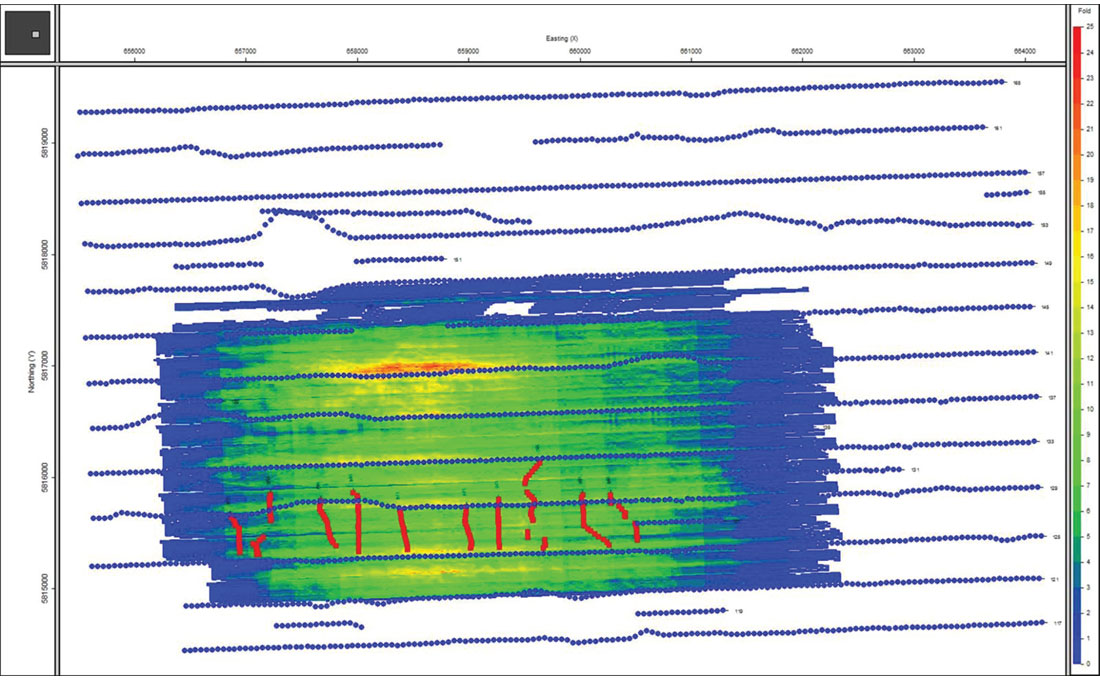
At the end of the conventional acquisition, as the recording crew was starting to pick up the geophone spread, ten individual vibrators were deployed to re-acquire about half a day’s worth of data along ten adjacent source lines. Each vibrator used exactly the same sweep parameters as before, but with a reduced VP spacing of 8.3 meters along the source line. The 8.3m VP interval resulted in the same total source energy per source line kilometer being applied during the test as was used during the conventional production, along the same source lines, and recorded into the same geophones. As with the conventional survey, all the test shot records were recorded both uncorrelated and correlated, and with no temporal overlap.
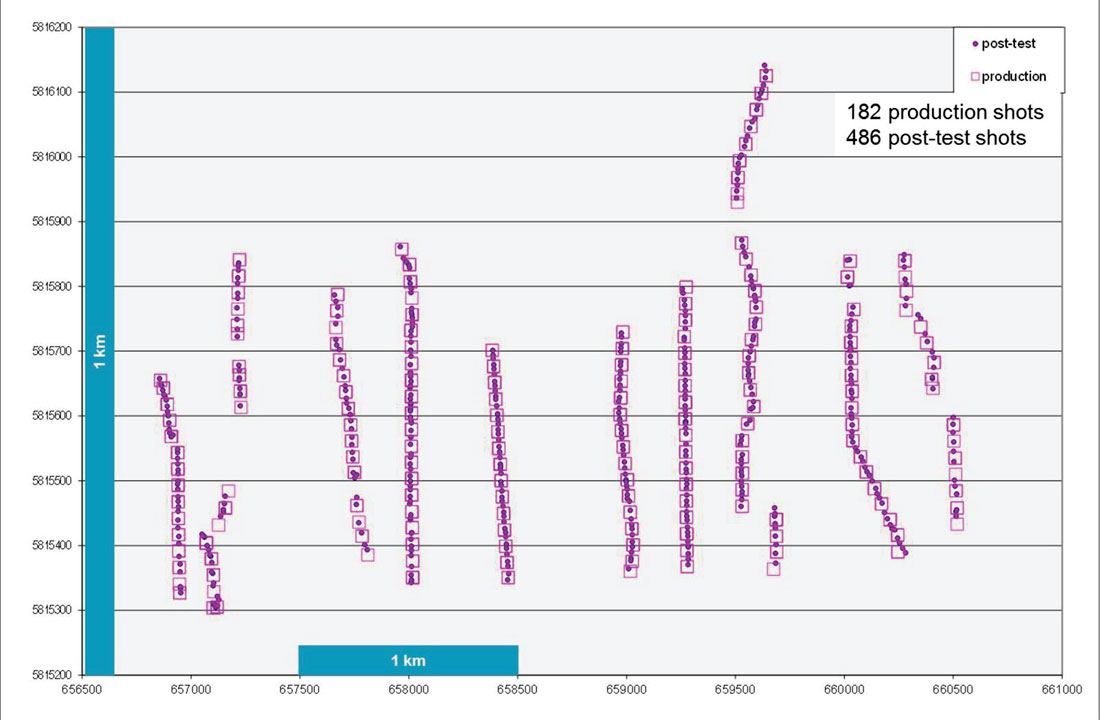
Figure 1 shows the test recording patch, the ten test source lines, and the resultant sub-surface coverage. Figure 2 shows a comparison of the production, three-vibrator VP locations and the single vibrator test VP locations. Figure 3 shows a full-fold 3D in-line stack within the test data area, at an intermediate stage in the data processing.
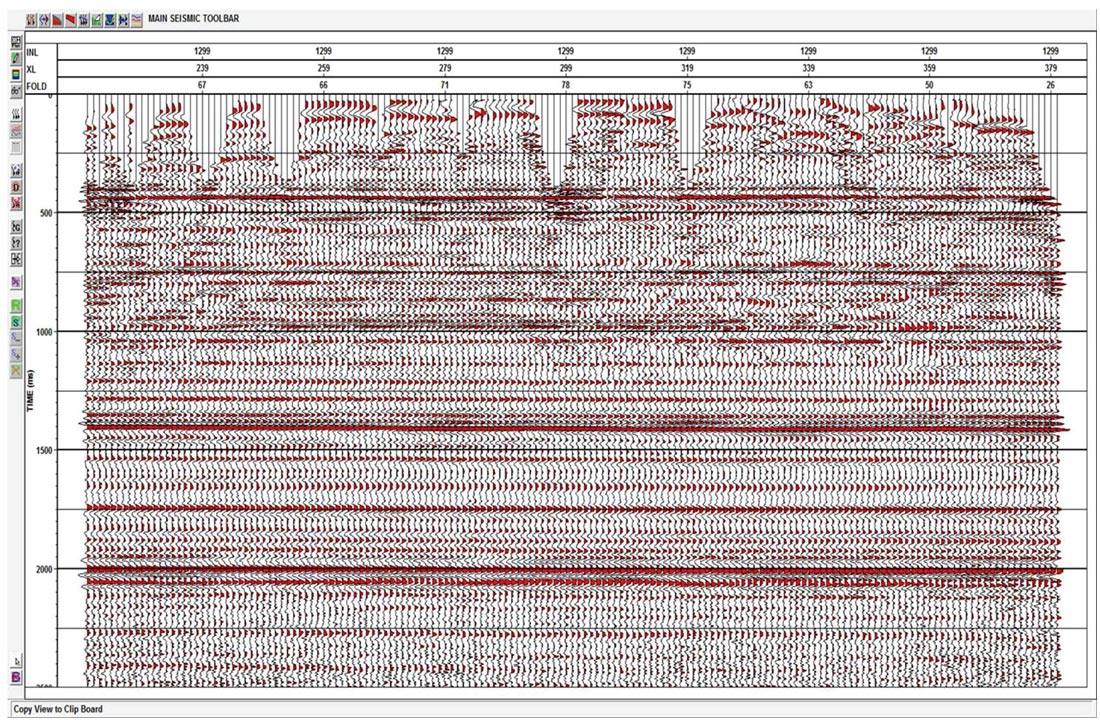
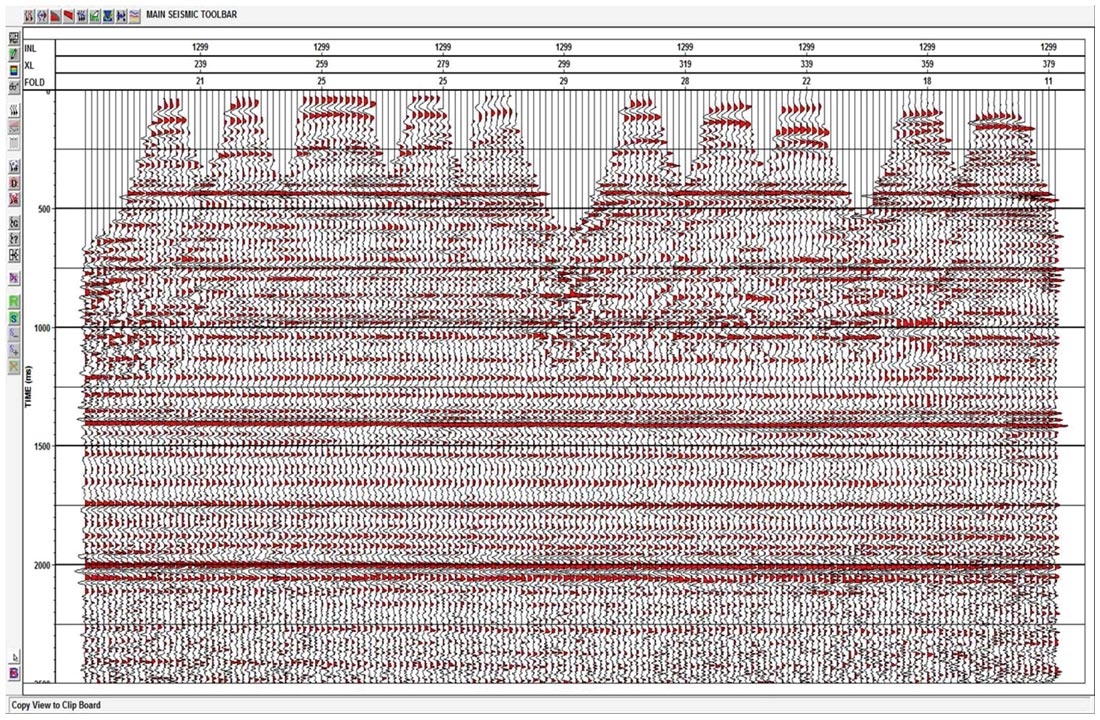
Figure 4 shows the 3D stack of the single vibrator, single sweep, test data along the same section profile as Figure 3, and Figure 5 shows the 3D stack of only those production shots that coincide with the Figure 4 test data. All three stacks have benefited from the same full-fold processing flow, with the same static correction routines, the same noise cancellation routines, and the same stacking velocities.
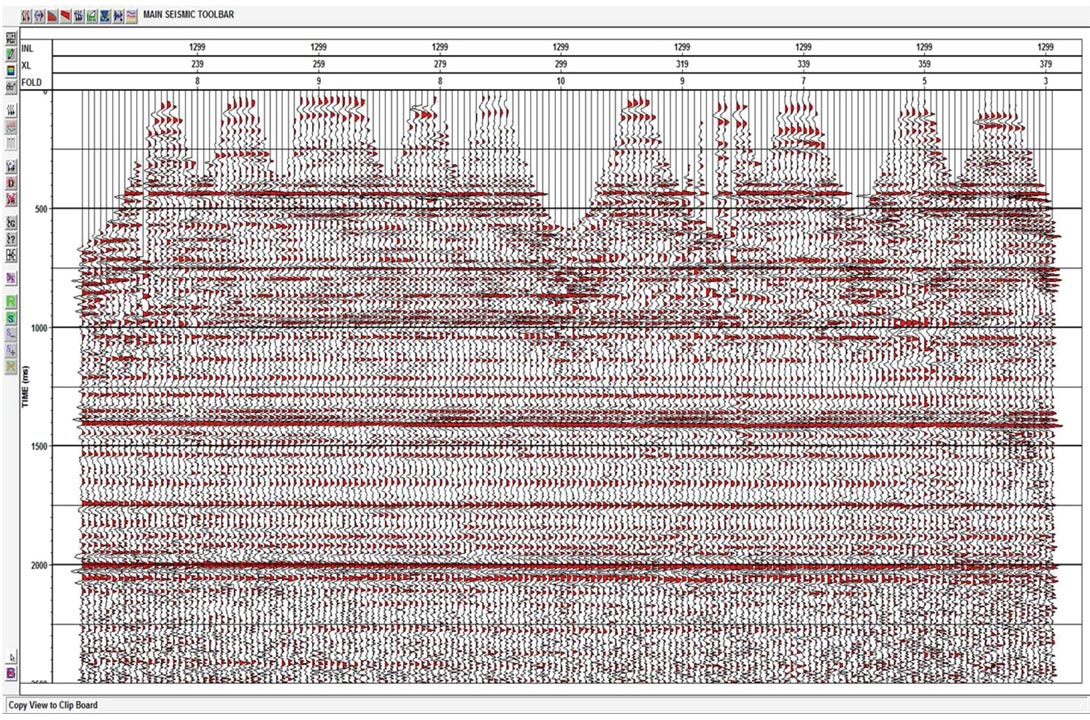
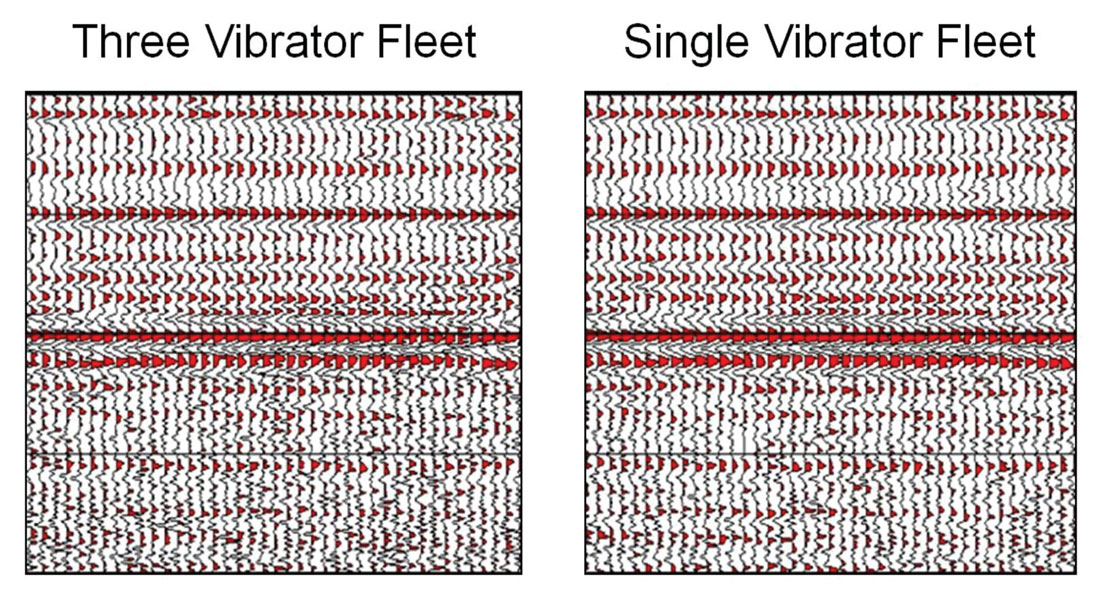
Figure 6 shows 400 msecs of data from the center of the two test stacks, centered on the prominent reflection at 2 seconds. Comparison of the weak reflections below 2 seconds shows an improved signal-to-noise ratio on the stack of the single vibrator, single sweep, data (right panel) compared to the stack of the equivalent production data (left panel). Since both data sets have been through an identical processing sequence, this improvement is most likely due to the superior noise cancellation of the higher fold test data (up to 30 fold) compared to the equivalent production data (up to 10 fold). This observation supports Quigley’s and Cooper’s comments, cited previously.
Eastern Alberta Survey
Following the Duvernay test, a full production 3D survey was designed in Eastern Alberta using the single vibrator, single sweep, source technology but using mini-vibrators (15,000 lbs HDW, 27 second linear up-sweep, 6-100 Hz) and a cable-less, nodal, recording system. The VP station spacing was 7.5 metres, the receiver station spacing was 30 meters with a single geophone per station, and the acquisition geometry used a conventional orthogonal design. Figure 7 shows an unprocessed common receiver gather from this survey. The overall high data quality of the field data suggests that the sweep length could have been reduced significantly without impacting the final result in any way.
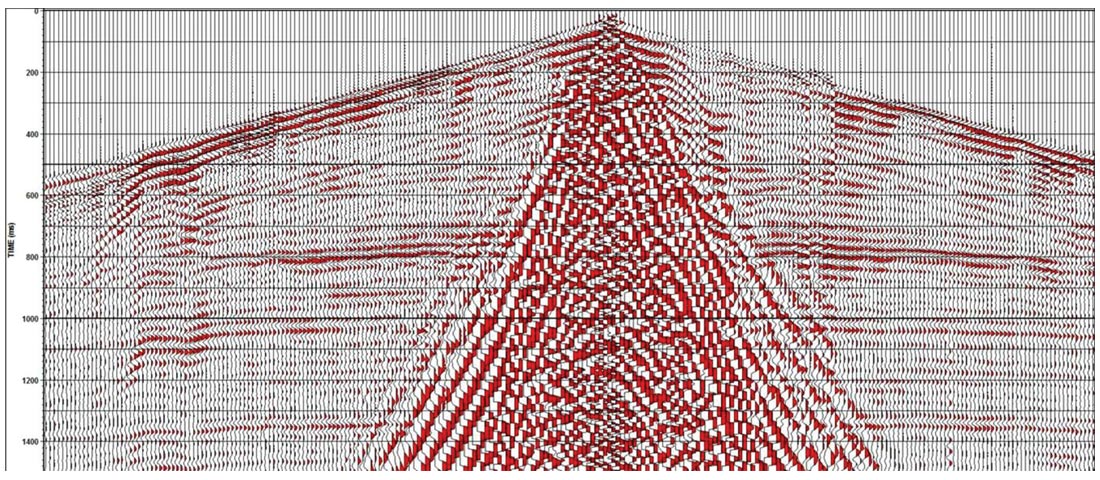
Figure 8 shows about one second of data from the full-fold 3D stack taken at an intermediate stage in data processing, with its associated frequency analysis. The frequency content of the reflection data covers almost the full range of the sweep signal, with 90 Hz reflection data being clearly visible throughout the geologic section on high frequency band-pass filter panels.
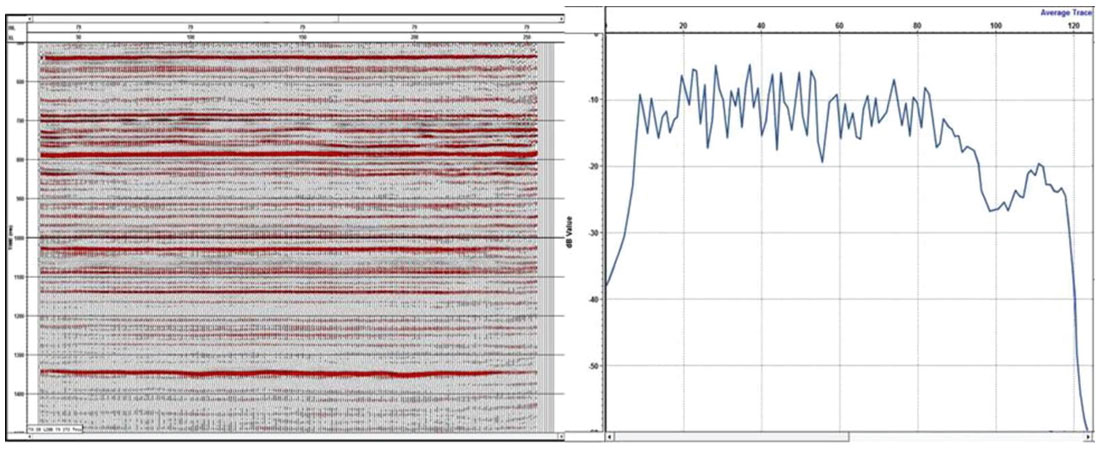
Figure 9 shows a similar one second section of data from the final, full-fold, stack of an adjacent 3D survey that was acquired using an explosive source (500 grams at 18 meters depth). This survey also used an orthogonal acquisition design, but with a 60 meter spacing for both the source and receiver stations. The stack is clearly noisier than Talisman’s Eastern Alberta vibroseis survey, and the associated frequency analysis shows the strong attenuation of reflection signal above 30 Hz, which we believe is primarily the consequence of the coarser spatial sampling in the source and receiver domains.

At the conclusion of the Eastern Alberta survey, the crew successfully recorded a large volume of single vibrator, single sweep, test data using the slip-sweep methodology. The next step in the process will be to evaluate the acquired slip sweep test data from the Eastern Alberta survey, and also to use the raw, individual, uncorrelated, field records to simulate and evaluate a variety of slip sweep efforts in the processing center.
Operational Considerations
Analysis of the Duvernay recording crew time shows that the single vibrator, single sweep, test records were recorded significantly more efficiently than were the equivalent production records. With ten independent vibrators, and with the reduced move-up of only 8.3 meters between adjacent VP locations, very little recording crew time was lost “waiting on vibrators”. The increase in the recording efficiency was sufficient to lead us to conclude that, if we had used a cableless recording system with sufficient channels to allow for a multi-swath recording operation, and assuming the appropriate degree of operations pre-planning and land permitting, we could likely have acquired the Duvernay survey using the single vibrator, single sweep, method with little or no increase in cost.
Following the successful Duvernay test, the cost of the Eastern Alberta survey was evaluated for a range of source options and acquisition geometry options, including a conventional deep-hole explosive source and also various “MegaBin” designs. Even without a simultaneous sweeping effort, and using the very conservative sweep length of 27 seconds, the total cost of the single vibrator, single sweep, high density, orthogonal survey design (ie exactly as it was acquired) was always competitive, which was a key deciding factor for the client Business Unit.
In summary, our analysis and our experience leads us to believe that with only a minimal application of the “slip sweep” concept, a recording crew using the single vibrator, single sweep, method combined with a cableless recording system, can achieve a similar, or even better, areal production per day as compared to a conventional vibroseis crew in WCSB, at an acceptable cost.
Conclusions
The Duvernay test shows that a single sweep from a single vibrator provides sufficient reflection energy to allow the data processors to image the complete sedimentary section in the WCSB with no loss in data quality. The same conclusion can be drawn from the mini-vibrator results from Eastern Alberta. Based on worldwide industry experience, the authors anticipate that slip-sweep simulation will prove successful in both cases, and will therefore provide a sound operational basis for the cost-effective acquisition of single vibrator, single sweep, 3D seismic data in the WCSB.
Wherever Vibroseis is viable in the WCSB, the use of single vibrator, single sweep plus slip sweep will deliver improved spatial sampling, an increased trace density and increased trace diversity, thereby resulting in an increased final data quality that can surpass that obtained from multi-vibrator fleets or even, in some cases, from explosive sources. And all of this can be achieved at a competitive cost. The uplift in trace density, trace diversity and data quality, will also be beneficial for seismic inversion and rock property extraction in the pre-stack domain.
So to answer our initial question : We believe that it is very possible that single vibrator, single sweep, 3D acquisition may be better, cheaper and faster than current acquisition methods over significant portions of the WCSB.
In closing, the authors acknowledge that this approach is already being used by some operators in Northern Alberta. The intent of this paper is to provide published case histories that can support its wider acceptance and application across the WCSB.

Acknowledgements
The authors would like to thank Talisman Energy Inc for permission to publish these results, CGG for acquiring the Duvernay test data, and SAE for acquiring the Eastern Alberta slip-sweep test data.










Join the Conversation
Interested in starting, or contributing to a conversation about an article or issue of the RECORDER? Join our CSEG LinkedIn Group.
Share This Article